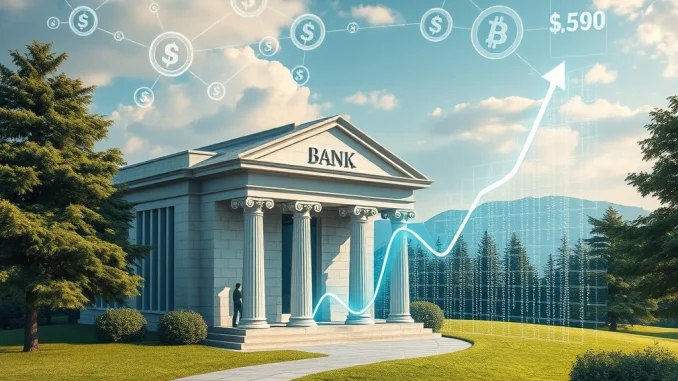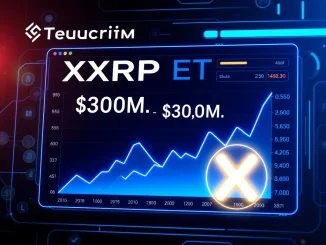
The financial world is abuzz with a seismic shift, and at its core is the **stablecoin surge** predicted by none other than Bank of America. For years, traditional banking and the burgeoning crypto space seemed like two distinct universes. Now, a groundbreaking forecast from one of the world’s leading financial institutions suggests a monumental convergence, with stablecoins poised to bridge this gap and redefine the future of finance.
Bank of America’s Bold Prediction: A $75B Stablecoin Surge on the Horizon
Imagine a financial landscape where the stability of traditional currencies meets the efficiency of blockchain technology. This isn’t a distant dream; it’s the near-term reality painted by Bank of America (BAC). Their recent analysis highlights a significant shift: traditional banks are not just observing the crypto space; they are actively preparing to launch their own crypto stablecoins. This strategic pivot underscores a deep commitment to integrating blockchain into conventional financial infrastructure.
Bank of America estimates that the stablecoin supply could expand by a staggering $25 billion to $75 billion in the near term. This isn’t just about new digital assets; it’s about fundamentally modernizing payment systems. Stablecoins, pegged to fiat currencies like the U.S. dollar, promise:
- Faster settlements
- Lower transaction fees
- Enhanced transparency
- Reduced operational costs compared to legacy methods
This projected **stablecoin surge** signifies a monumental vote of confidence from a major financial player, signaling a new era for digital assets within regulated frameworks.
The Power of Regulatory Clarity: Why the GENIUS Act Matters
What’s fueling this confidence among banking giants? A critical factor is the progress in establishing **regulatory clarity**. Bank of America CEO Brian Moynihan has emphasized that clear guidelines are paramount for institutions to move forward with stablecoin initiatives. Legislation, such as the proposed GENIUS Act, aims to establish a robust framework for stablecoin operations, significantly reducing uncertainty for banks and other financial entities.
Without a clear regulatory roadmap, banks face significant compliance risks. The push for legislative support indicates a collective desire within the financial industry to operate within defined boundaries, ensuring both innovation and consumer protection. This clarity is not just about avoiding pitfalls; it’s about unlocking new opportunities for growth and efficiency within a secure environment.
Institutional Adoption: Paving the Way for Digital Assets
The forecast for a substantial **stablecoin surge** is heavily reliant on increasing **institutional adoption**. Banks are not just experimenting; they are strategically positioning themselves to leverage stablecoins for a variety of use cases, from interbank settlements to cross-border payments. This involves:
- Tokenizing financial infrastructure: Converting traditional assets and processes onto blockchain.
- Competing with fintech and DeFi: Offering digital solutions that rival innovative startups and decentralized finance platforms.
- Consortium-led models: Collaborating with other banks to share risks, develop industry standards, and mitigate individual liabilities. This collaborative approach fosters a more secure and standardized ecosystem for stablecoins.
The implications of this institutional embrace are far-reaching. Increased stablecoin adoption could bolster demand for U.S. Treasury securities, as stablecoin reserves often require high-quality liquid assets. This dynamic could reinforce the U.S. dollar’s dominance in global finance, integrating digital assets into traditional markets while strengthening existing financial structures.
Navigating the Digital Economy: Opportunities and Challenges
The shift toward stablecoins reflects a broader, undeniable trend: the convergence of blockchain technology with traditional finance, shaping the very fabric of the **digital economy**. Banks are keen to retain relevance in a landscape increasingly defined by digital innovations. By entering the stablecoin space, they aim to:
- Modernize payment rails for speed and cost-efficiency.
- Create new revenue streams through digital asset services.
- Enhance liquidity management and capital efficiency.
However, this ambitious transition isn’t without its hurdles. Bank of America acknowledges challenges such as:
- Liquidity management: Ensuring sufficient reserves to meet redemption demands.
- Counterparty exposure: Managing risks associated with various participants in the stablecoin ecosystem.
- Consumer education: Bridging the knowledge gap for widespread public adoption.
Despite these uncertainties, the commitment to robust governance frameworks and compliance with evolving regulations remains steadfast. The industry’s approach is cautious yet forward-looking, aiming to harness the benefits of blockchain without replicating the volatility and risks associated with speculative cryptocurrencies.
What Does This Mean for the Future of Finance?
Bank of America’s analysis highlights a pivotal moment in financial history. Stablecoins could redefine the role of banks, transforming them from traditional custodians to facilitators of a more efficient, digital-first financial system. While regulatory and market readiness remain key variables, the firm’s emphasis on collaboration and compliance suggests a measured strategy. This approach mirrors the broader industry’s attempt to harness the benefits of blockchain without replicating the volatility and risks associated with speculative cryptocurrencies. The future of finance is undoubtedly digital, and stablecoins are emerging as a crucial bridge.
Frequently Asked Questions (FAQs)
What is a stablecoin?
A stablecoin is a type of cryptocurrency designed to maintain a stable value, typically by being pegged to a fiat currency like the U.S. dollar, or backed by commodities or other cryptocurrencies. They aim to combine the benefits of blockchain technology (speed, transparency) with the stability of traditional assets.
Why are traditional banks interested in stablecoins?
Traditional banks are interested in stablecoins to modernize payment systems, enabling faster and cheaper transactions, reducing operational costs, and competing with fintech firms and decentralized finance (DeFi) platforms. They see stablecoins as a way to integrate blockchain technology into their existing infrastructure.
What role does regulatory clarity play in stablecoin adoption?
Regulatory clarity is crucial for banks because it provides a legal framework and reduces uncertainty regarding compliance, consumer protection, and operational guidelines. Clear regulations, like those proposed by the GENIUS Act, allow banks to confidently invest in and launch stablecoin initiatives without significant legal risks.
How big is the predicted stablecoin surge by Bank of America?
Bank of America estimates that the stablecoin supply could expand by $25 billion to $75 billion in the near term, driven by institutional participation and legislative support.
What are the potential challenges for banks adopting stablecoins?
Key challenges include managing liquidity effectively, mitigating counterparty exposure risks, and educating consumers about stablecoins to ensure widespread understanding and adoption. Banks must also navigate evolving compliance requirements and robust governance frameworks.
How might stablecoins impact the U.S. dollar’s global dominance?
Increased stablecoin adoption, especially those pegged to the U.S. dollar and requiring U.S. Treasury securities as reserves, could potentially reinforce the U.S. dollar’s dominance in global finance by integrating digital assets into traditional markets and expanding its reach in the digital economy.



